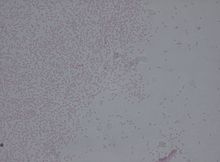Pantoea agglomerans

| Pantoea agglomerans | |
|---|---|
| Scientific classification | |
| Kingdom: | |
| Phylum: | |
| Class: | Gamma Proteobacteria
|
| Order: | |
| Family: | |
| Genus: | |
| Binomial name | |
| Pantoea agglomerans (Ewing and Fife 1972)
Gavini et al. 1989 | |
| Type strain | |
| ATCC 27155 CCUG 539 CDC 1461-67 CFBP 3845 CIP 57.51 DSM 3493 ICPB 3435 ICMP 12534 JCM 1236 LMG 1286 NCTC 9381 | |
| Synonyms | |
|
Enterobacter agglomerans Ewing and Fife 1972 | |
Pantoea agglomerans is a Gram-negative bacterium that belongs to the family Enterobacteriaceae.
Formerly called Enterobacter agglomerans or Erwinia herbicola, it is an ubiquitous bacterium commonly isolated from plant surfaces, seeds, fruit, and animal or human feces.
Bacteriology
Research has shown that Pantoea agglomerans can serve as a plant pathogen competitor for the management of plant diseases. Fire blight, a plant disease caused by bacterium Erwinia amylovora, is commonly found in pear and apple crops.[1] After coming in contact with Erwinia amylovora, Pantoea agglomerans produces antibiotic properties that are toxic to the fire blight-inducing bacterium. It has been identified that it is possible that habitat modification or exclusion may also play a role in the effectiveness of the antibiosis of the fire blight biological control.[2]
Environmental factors influencing the growth and spread of Pantoea agglomerans include winter chilling, good sunlight exposure and quality air circulation.[3] In order for fruit-bearing trees, such as apple and pear trees, which are common Pantoea agglomerans hosts, to bloom, it is essential that they receive a period of chilling to revive them from their dormant state in the following Spring. In terms of sunlight exposure, fruit trees generally grow best in warm, moist and well-lit environments, thus Pantoea agglomerans must also be able to survive under these conditions if it hopes to infect healthy plant hosts. Additionally, since Pantoea agglomerans is an aerobic bacterium, it requires a certain level of air circulation in order to survive.[4]
Pantoea agglomerans is found in the gut of locusts. The locusts have adapted to use the guaiacol produced by Pantoea agglomerans to initiate the synchronized swarming of locusts.[5]
It is also commonly found as a symbiont in the gut of mosquitoes. Scientists have created a genetically modified strain of Pantoea agglomerans produce antimalarial effector molecules. Inoculating mosquitoes with this strain reduced the prevalence of the Malaria causing organism (Plasmodium) by up to 98%.[6]
Clinical isolates
Pantoea agglomerans is occasionally reported to be an opportunistic pathogen in immunocompromised patients, causing wound, blood, and urinary-tract infections. Infections are typically acquired from infected vegetation parts penetrating the skin. Contaminated intravenous fluids or blood products are only rarely the causal agent.[7] Bloodstream infection can lead to disseminated disease and end-organ infection, mainly septic arthritis, but also endophthalmitis, periostitis, endocarditis and osteomyelitis in humans.[8]
Using the biochemical panels commonly employed in medical diagnostics it is difficult to differentiate Pantoea agglomerans from other species of the same genus or from members of related families such as Enterobacter, Klebsiella, and Serratia spp.[9] This has led to confusion surrounding its pathogenicity as molecular studies based on DNA sequencing have disproved the identity of several clinical isolates initially reported as Pantoea agglomerans.[10][11] For the precise identification of Pantoea agglomerans non-culture based methods such as Multilocus sequence typing (MLST) or Whole-Cell MALDI-TOF MS are recommended.[12]
References
- ^ Anderson, L. M.; Stockwell, V. O.; Loper, J. E. (November 2004). "An Extracellular Protease of Pseudomonas fluorescens Inactivates Antibiotics of Pantoea agglomerans". Phytopathology. 94 (11): 1228–1234. doi:10.1094/phyto.2004.94.11.1228. PMID 18944458.
- ^ Johnson, K. B.; Stockwell, V. O.; Sugar, D; Loper, J. E. (November 2002). "Antibiosis Contributes to Biological Control of Fire Blight by Pantoea agglomerans Strain Eh252 in Orchards". Phytopathology. 92 (11): 1202–9. doi:10.1094/phyto.2002.92.11.1202. PMID 18944246.
- ^ Johnson, K. B.; Stockwell, V. O.; Sugar, D; Sawyer, T. L. (November 2000). "Assessment of Environmental Factors Influencing Growth and Spread of Pantoea agglomerans on and Among Blossoms of Pear and Apple". Phytopathology. 90 (11): 1285–94. doi:10.1094/PHYTO.2000.90.11.1285. PMID 18944433.
- ^ "Climate and aspect". Apple and Pear Australia Limited. 2009. Retrieved December 15, 2016.
{{cite web}}: Unknown parameter|deadurl=ignored (|url-status=suggested) (help) - ^ Nature, Pheromones: Exploitation of gut bacteria in the locust
- ^ Wang, Sibao; et al. (2012). "Fighting malaria with engineered symbiotic bacteria from vector mosquitoes". Proceedings of the National Academy of Sciences. 109 (31): 12734–12739. doi:10.1073/pnas.1204158109.
{{cite journal}}: Explicit use of et al. in:|last2=(help) - ^ Cruz, A. T.; Cazacu, A. C.; Allen, C. H. (2007-04-18). "Pantoea agglomerans, a Plant Pathogen Causing Human Disease". Journal of Clinical Microbiology. 45 (6): 1989–1992. doi:10.1128/JCM.00632-07. PMC 1933083. PMID 17442803.
- ^ Dutkiewicz, J; Mackiewicz, B; Kinga Lemieszek, M; Golec, M; Milanowski, J (2016-06-02). "Pantoea agglomerans: A mysterious bacterium of evil and good. Part III. Deleterious effects: Infections of humans, animals and plants". Annals of Agricultural and Environmental Medicine. 23 (2): 197–205. doi:10.5604/12321966.1203878. PMID 27294620.
- ^ Rezzonico, F.; Stockwell, V.o.; Tonolla, M.; Duffy, B.; Smits, T.h.m. (2012-04-01). "Pantoea clinical isolates cannot be accurately assigned to species based on metabolic profiling". Transplant Infectious Disease. 14 (2): 220–221. doi:10.1111/j.1399-3062.2011.00684.x. ISSN 1399-3062.
- ^ Rezzonico, Fabio; Smits, Theo HM; Montesinos, Emilio; Frey, Jürg E.; Duffy, Brion (2009-01-01). "Genotypic comparison of Pantoea agglomerans plant and clinical strains". BMC Microbiology. 9: 204. doi:10.1186/1471-2180-9-204. ISSN 1471-2180. PMC 2764716. PMID 19772624.
{{cite journal}}: CS1 maint: unflagged free DOI (link) - ^ Delétoile, Alexis; Decré, Dominique; Courant, Stéphanie; Passet, Virginie; Audo, Jennifer; Grimont, Patrick; Arlet, Guillaume; Brisse, Sylvain (2009-02-01). "Phylogeny and Identification of Pantoea Species and Typing of Pantoea agglomerans Strains by Multilocus Gene Sequencing". Journal of Clinical Microbiology. 47 (2): 300–310. doi:10.1128/JCM.01916-08. ISSN 0095-1137. PMC 2643697. PMID 19052179.
- ^ Rezzonico, Fabio; Vogel, Guido; Duffy, Brion; Tonolla, Mauro (2010-07-01). "Application of Whole-Cell Matrix-Assisted Laser Desorption Ionization-Time of Flight Mass Spectrometry for Rapid Identification and Clustering Analysis of Pantoea Species". Applied and Environmental Microbiology. 76 (13): 4497–4509. doi:10.1128/AEM.03112-09. ISSN 0099-2240. PMC 2897409. PMID 20453125.
